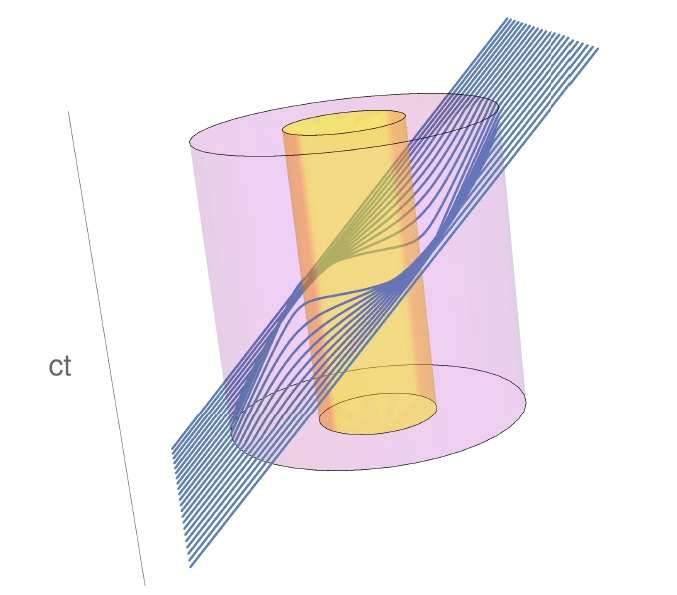March 10, 2016 report
Invisibility cloaks can never hide objects from all observers

(Phys.org)—Ideal invisibility cloaks like those in Harry Potter may be physically impossible, a new study shows. The researchers demonstrate that even the best invisibility cloaks can hide an object from only some observers, while other observers moving with respect to the first group would see distortions.
The physicists, Jad Halimeh at the Ludwig Maximilian University of Munich, Germany, and Robert Thompson at the University of Otago, New Zealand, have published a paper on the limitations of invisibility cloaks in a recent issue of Physical Review A.
As the researchers explain, limitations imposed by special relativity mean that the best invisibility cloaks would only be able to render objects partially transparent because they would suffer from obvious visible distortions due to motion. The result would be less Harry Potter and more like the translucent creatures in the 1987 movie Predator.
"In principle, what this paper shows is that invisibility cloaking is not possible for all observers," Halimeh told Phys.org. "Real invisibility cloaks will have to stay in the realm of fiction. Your cloak, if it is to be pragmatically broadband, will pretty much look like that of Predator, giving away what it hides via distortions when you move relative to it."
In general, an invisibility cloak works by diverting the path of light around an object so that it continues on the other side as if the object were not there. In previous research, scientists have noted a problem with the way this works. The straight path directly through a region of space is always shorter than the path that curves around the region, so it would take longer for light to travel around the object it's concealing than to go straight through. This time delay can lead to visible distortions.
Many previously reported invisibility cloaks have gotten around this limitation by cloaking objects from only a single frequency of light, such as a particular frequency in the microwave range or one specific color in the visible range. All other frequencies reflect back off the object or take a different trajectory than the one the cloaked light takes, making the object clearly visible. Since every wavefront is identical to every other in a pure wave, it is possible to engineer single-frequency cloaks with no time delay.
As the researchers showed in a previous paper, single-frequency cloaks suffer from another problem: when moving at fast speeds, they become visible due to a relativistic Doppler effect that shifts the frequency of incoming light away from the cloak's operating frequency.
In their new paper, the physicists have wondered whether there might be a type of invisibility cloak that could meet the expectations of Harry Potter, including full-spectrum (broadband) frequency cloaking and the ability to maintain invisibility when in motion.
They have investigated a type of cloak known as an "amplitude cloak" because it preserves only the amplitude of light, and not its phase (which is shifted by the time delay). By intentionally creating a time delay, the amplitude cloak makes it possible to cloak light across several frequencies. This type of cloak has already been realized in many labs, including in the US, Germany, and China.
Unfortunately, the researchers show here that an amplitude cloak would only work when both the cloaked object and an observer are completely stationary. If one or the other were to move, then the cloaked object would become visible—maybe not crystal clear, but image distortions would at least reveal its presence.
The reason why movement destroys the invisibility effect has nothing to do with the Doppler shift like with single-frequency cloaks, but rather because of something called Fresnel-Fizeau drag. As scientists discovered in the 1800s, light traveling through a moving medium is dragged along by the medium. So a moving amplitude cloak would drag light waves to different areas of space as seen by a stationary observer, making the image appear distorted.
The researchers found that the image distortions induced by Fresnel-Fizeau drag increase in severity with the relative speed of the cloak and observer and as the cloak's bandwidth increases. However, even at the slowest speeds and at small bandwidths, when the image distortions may not be visible to the naked eye, the distortions could in principle be detected with a sensitive detector. Overall, this motion problem stems from the fact that an amplitude cloak does not preserve the phase of light.
"Although our results may be disappointing for would-be wizards, understanding the limitations of cloaking devices is actually important in real life," Thompson said. "New technologies are beginning to emerge from cloaking research, and we're looking for effects that could either compromise the functionality of these technologies, or which could be exploited for some new practical purpose in the future."
More information:
Jad C. Halimeh and Robert T. Thompson. "Fresnel-Fizeau drag: Invisibility conditions for all inertial observers." Physical Review A. DOI: 10.1103/PhysRevA.93.033819
Also at arXiv:1601.04218 [physics.optics]
Journal information: Physical Review A
© 2016 Phys.org



















